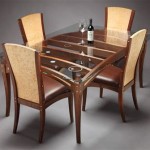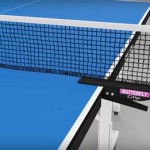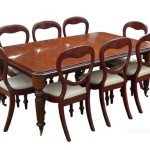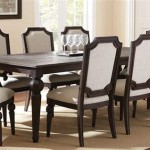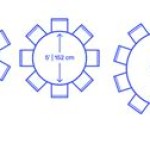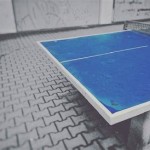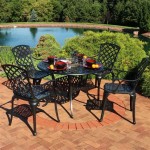How To Make A Penny Covered Table
Creating a penny-covered table is a unique and visually appealing project that transforms an ordinary piece of furniture into a conversation starter. This endeavor, while time-consuming, is relatively straightforward and yields a durable and distinctive surface. Careful planning, proper materials, and methodical execution are essential for a successful outcome. This article provides a detailed guide on how to construct a penny-covered table, covering preparation, adhesion, grouting, and sealing.
Preparation and Planning: Essential First Steps
The initial phase of crafting a penny-covered table is arguably the most critical, involving meticulous planning and preparation. This ensures a smooth and efficient construction process, minimizing potential issues down the line. Selection of the table, penny cleaning and sorting, and design considerations are the primary elements that need thorough attention.
Table Selection: The table to be covered serves as the foundation for the entire project. The ideal table should have a smooth, solid surface capable of supporting the weight of the pennies, adhesive, and grout. Tables constructed from wood, MDF (Medium-Density Fiberboard), or even metal are suitable options. Avoid tables with intricate carvings or uneven surfaces, as these can make the penny application process significantly more challenging. The size and shape of the table will dictate the number of pennies required, impacting the overall cost and labor involved. It is crucial to assess the structural integrity of the table to prevent any future warping or collapse due to the added weight.
Penny Cleaning and Sorting: The appearance of the final penny-covered table is significantly influenced by the condition and uniformity of the pennies used. Over time, pennies accumulate dirt, grime, and oxidation, resulting in a tarnished look. Cleaning the pennies is therefore imperative to achieve a visually appealing result. A simple method involves soaking the pennies in a solution of vinegar and salt. The acidic properties of the vinegar, combined with the abrasive action of the salt, effectively remove tarnish and grime. The pennies should be soaked for a period of time, typically between 30 minutes and several hours, depending on the level of tarnish. Rinse the pennies thoroughly with water and dry them completely before proceeding. Sorting the pennies by year or degree of tarnish is also recommended. This can allow for creating patterns or highlighting specific areas of the table with variations in color and tone. Consider purchasing bulk pennies if you require a specific quantity or are struggling to collect enough.
Design Considerations: Before commencing the penny application, it is beneficial to create a design plan. This involves outlining the layout of the pennies on the table surface. A simple grid pattern is the most common and straightforward approach. However, more intricate designs, such as geometric patterns, initials, or even pictorial representations, can be incorporated. The design should be sketched out on paper or digitally using graphic design software. This allows for visualizing the final product and calculating the precise number of pennies required. It is important to account for the spacing between pennies, as this will influence the amount of grout needed. Furthermore, consider the edge treatment of the table. Options include wrapping the pennies around the edge, creating a flush edge with the pennies, or using a decorative trim to conceal the raw edges.
The Application Process: Adhesion and Arrangement
The core of the penny-covering project lies in the application of the pennies to the table surface. This stage requires patience, precision, and a suitable adhesive. The chosen adhesive must provide a strong, durable bond between the pennies and the table surface, ensuring that the pennies remain securely in place over time. The method of application also plays a crucial role in the overall aesthetic and structural integrity of the finished table.
Adhesive Selection: Selecting the right adhesive is crucial for the longevity and durability of the penny-covered table. Several types of adhesives are suitable for this project, each with its own advantages and disadvantages. Epoxy resin is a popular choice due to its exceptional strength and water resistance. It provides a permanent bond and can withstand considerable stress. However, epoxy resin typically requires careful mixing and has a limited working time. Construction adhesive, designed for bonding various materials, is another viable option. It offers good adhesion and is relatively easy to apply. However, it may not be as water-resistant as epoxy resin. Hot glue can be used for temporary tacking or for smaller projects, but its long-term durability is questionable. Consider the size of the project, the intended use of the table, and the environmental conditions it will be exposed to when selecting the adhesive.
Penny Arrangement: The arrangement of the pennies directly impacts the aesthetic appeal of the finished table. The most common approach is to arrange the pennies in a consistent orientation, either heads-up or tails-up. However, alternating the orientation can create a more visually dynamic effect. It is essential to maintain consistent spacing between the pennies to ensure a uniform grout line. Small spacers, such as toothpicks or cardboard shims, can be used to achieve consistent spacing. Start by applying a small amount of adhesive to the back of each penny and then carefully positioning it on the table surface according to the design plan. Press the penny firmly into place and allow the adhesive to cure according to the manufacturer's instructions. Work in small sections to prevent the adhesive from drying out before the pennies are applied. Regularly check the alignment of the pennies to ensure that the pattern remains consistent.
Edge Treatment: The edges of the table require special attention during the penny application process. Several options exist for treating the edges, each with its own pros and cons. Wrapping the pennies around the edge creates a seamless transition from the table surface to the edge. This option requires carefully cutting and shaping the pennies to fit the curvature of the edge. Creating a flush edge involves aligning the pennies with the table's edge, resulting in a clean, contemporary look. This option may require using a sander or grinder to smooth the edges of the pennies. Applying a decorative trim, such as wood molding or metal edging, can conceal the raw edges of the pennies and provide a more finished appearance. This option offers a wide range of design possibilities and can complement the overall aesthetic of the table.
Grouting and Sealing: Completing the Transformation
Once the pennies are securely adhered to the table surface, the final steps involve grouting the spaces between the pennies and sealing the entire surface. Grouting fills the gaps between the pennies, providing a smooth, even surface and preventing dirt and debris from accumulating. Sealing protects the pennies and grout from moisture, stains, and wear and tear, ensuring the longevity and beauty of the finished table.
Grout Selection and Application: Grout is a cementitious material used to fill the spaces between tiles or, in this case, pennies. Several types of grout are available, each with varying properties and applications. Cement-based grout is the most common and affordable option. It is available in sanded and unsanded varieties. Sanded grout is recommended for wider grout lines, while unsanded grout is suitable for narrower grout lines. Epoxy grout is a more durable and water-resistant option, but it is also more expensive and requires more careful application. Select a grout color that complements the pennies and enhances the overall design. Apply the grout using a grout float, spreading it evenly over the entire surface of the table. Press the grout firmly into the spaces between the pennies, ensuring that all the gaps are filled. Remove excess grout with a damp sponge, wiping in a diagonal direction across the penny surface. Allow the grout to dry according to the manufacturer's instructions before proceeding to the next step.
Cleaning and Polishing: After the grout has dried, a haze may remain on the surface of the pennies. This haze can be removed using a grout haze remover or a mild acid solution. Apply the cleaner to the surface of the table and scrub gently with a soft brush or sponge. Rinse thoroughly with water and dry completely. Once the haze has been removed, the pennies can be polished to enhance their shine. A metal polish specifically designed for copper can be used to achieve a high-gloss finish. Apply the polish to a soft cloth and rub it onto the surface of the pennies in a circular motion. Buff the pennies with a clean cloth to remove any excess polish and reveal their shine.
Sealing the Table: Sealing the penny-covered table is essential to protect it from moisture, stains, and wear and tear. A clear sealant, such as polyurethane or epoxy resin, is typically used for this purpose. Polyurethane provides a durable, water-resistant finish and is relatively easy to apply. Epoxy resin offers superior water resistance and durability, but it requires more careful mixing and application. Apply the sealant according to the manufacturer's instructions, using a brush, roller, or spray gun. Apply multiple coats of sealant, allowing each coat to dry completely before applying the next. Ensure that the sealant covers all surfaces of the pennies and grout, providing a uniform protective layer. The final result is a durable, water-resistant, and visually stunning penny-covered table.

Heart Maine Home How To Make A Penny Top Table Diy

Diy Glaze Coated Penny Table Top Project Tops Furniture Makeover

Penny Countertop Wildfire Interiors

Diy How To Make A Penny Side Table Tutorial And Cover With

Penny Bowl Fail Let S Get Crafty

How To Make A Penny Coffee Table Finding Mandee

Beromatic Penny Table

Diy Penny Table Inspired

How To Make A Desk Using Pennies

How To Make A Penny Top Coffee Table Diy Tops

